

![]()
Program Manager: Charles E. Rodes, PhD, charlesr@rti.org
The primary goal of the Aerosol Exposure Research program within RTIís Center for Engineering and Environmental Technology is to document the extent that people are exposed to particles in their surroundings. Secondary objectives center on improving the precision, accuracy and representativeness of exposure measurements. Program research considers traditional particle sources (e.g. industrial processes), as well as those that are not as obvious (e.g. re-suspended housedust from vacuuming and walking on carpeting). A number of particle size fractions are studied from both occupational and ambient settings, including respirable, inhalable (inspirable), and thoracic. Particle exposure pathways currently under study include air (via inhalation) and dermal (e.g. hand-to-surface contact). The concentration levels of particles and contaminants in the breathing zone (personal exposure) during residential and occupational activities are evaluated using a miniature personal exposure sampling system developed at RTI to improve the precision and accuracy of exposure measurements, while being unobtrusive.
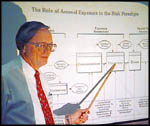 Dr. David Ensor explains the relationships between particle exposure and risk. |
![]() Determination of particle size distributions and concentrations levels of housedust re-suspended into the air by walking
Determination of particle size distributions and concentrations levels of housedust re-suspended into the air by walking
![]() Assessment of soil track-in on shoes into residences and onto carpeting
Assessment of soil track-in on shoes into residences and onto carpeting
![]() Determined the source categories responsible for elevated lead (Pb) exposures in the population of Cairo (Egypt) using a receptor modeling technique
Determined the source categories responsible for elevated lead (Pb) exposures in the population of Cairo (Egypt) using a receptor modeling technique
![]() Assessment of the particle emissions from residential vacuum cleaners
Assessment of the particle emissions from residential vacuum cleaners
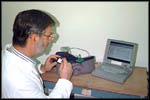 Dr. Phil Lawless downloads data from RTI's custom-designed Personal Exposure Particle Sampling system into a computer. |
![]() Development of an unobtrusive particle exposure sampling system that is worn either as a waist pack or a backpack, and collects filter samples up to 7 days. Quality control data are stored in an on-board miniature data logger
Development of an unobtrusive particle exposure sampling system that is worn either as a waist pack or a backpack, and collects filter samples up to 7 days. Quality control data are stored in an on-board miniature data logger
![]() Evaluation of the potential biases in personal exposure measurements that influence their accuracy or representativeness
Evaluation of the potential biases in personal exposure measurements that influence their accuracy or representativeness
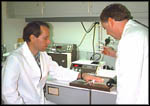 Randy Newsome and Dr. Charles Rodes study the transfer rate of particles to the hand. |
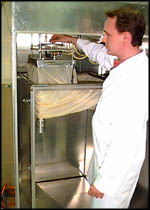 Jeff Antley adjusts the particle generator in preparation for depositing uniform particle coatings on test surfaces. |
![]() Development of a particle generation chamber to uniformly coat test surfaces with specific particle sizes for dermal contact experiments
Development of a particle generation chamber to uniformly coat test surfaces with specific particle sizes for dermal contact experiments
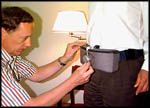 Dr. Rodes adjusts the particle sampling inlet for a test subject. |
![]() Supported the particle exposure assessment (personal, indoor and outdoor) for 300 randomly selected individuals as part of a multi-media exposure study across five Midwestern states
Supported the particle exposure assessment (personal, indoor and outdoor) for 300 randomly selected individuals as part of a multi-media exposure study across five Midwestern states
![]() Supported the particle exposure assessment (personal, indoor and outdoor) for 1000 randomly selected individuals estimate the populations exposure distributions to a selected particle-phase metals in Toronto, Canada, and 300 individuals in Indianapolis, Indiana
Supported the particle exposure assessment (personal, indoor and outdoor) for 1000 randomly selected individuals estimate the populations exposure distributions to a selected particle-phase metals in Toronto, Canada, and 300 individuals in Indianapolis, Indiana
![]() Conducted an in-vehicle particle exposure study to determine passenger exposure levels for PM2.5 and PM10 particles, metals, and organics for various in-traffic driving scenarios
Conducted an in-vehicle particle exposure study to determine passenger exposure levels for PM2.5 and PM10 particles, metals, and organics for various in-traffic driving scenarios
![]()
Home || Research Areas || Facilities || Staff || Publications || Contact || RTI Programs
tjm@rti.org
URL: http://clean.rti.org/aerosol/research.htm